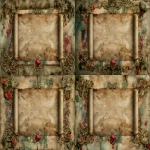Explore the Best AI Image Gallery

AI: The Creative Catalyst - Reshaping the Graphic Design Landscape
The world of graphic design is undergoing a seismic shift driven by the rapid advancements in artificial intelligence (AI). No longer confined to the realm of science fiction, AI is now a tangible force, impacting every facet of the creative process, from ideation and design to execution and refinement.
Automating the Workflow
One of the most immediate impacts of AI in graphic design is its ability to automate repetitive tasks. Tools powered by machine learning algorithms can generate variations of logos, create social media graphics, and even produce basic layouts with remarkable speed and accuracy. This frees up designers to focus on higher-level creative endeavors, such as conceptualizing campaigns, developing brand identities, and crafting compelling narratives.
AI-Powered Design Assistants
Imagine having a virtual design assistant that understands your vision and can bring it to life. AI-powered design assistants are emerging as powerful tools that can generate visuals based on text prompts, refine existing designs, and even suggest color palettes and typography choices. These assistants act as intelligent collaborators, accelerating the design process and pushing creative boundaries.
Unlocking New Creative Possibilities
Beyond automation, AI is also opening up exciting new avenues for creativity. Generative adversarial networks (GANs), a type of deep learning algorithm, can create entirely original designs, from abstract art to realistic illustrations. This opens up a world of possibilities for designers to experiment with novel styles and explore uncharted creative territories.
Personalizing the Design Experience
AI has the potential to personalize the design experience like never before. By analyzing user preferences, behavior patterns, and even emotional cues, AI-powered systems can generate designs that are tailored to individual tastes and needs. This level of personalization can create a more engaging and impactful design experience for users.
Ethical Considerations
As with any powerful technology, the integration of AI into graphic design raises important ethical considerations.
- Bias in Algorithms: AI algorithms are trained on massive datasets, which can inadvertently reflect existing societal biases. This can result in designs that perpetuate stereotypes or discriminate against certain groups.
- Copyright and Ownership: The question of copyright ownership for AI-generated designs is still evolving. Who owns the rights to a design created by an algorithm?
- Job Displacement: There are concerns that AI automation could lead to job losses in the graphic design industry. Its essential to consider the impact on human designers and explore ways to ensure a smooth transition.
Future Trends
The future of AI in graphic design is brimming with possibilities.
- More Human-AI Collaboration: Well see a shift towards closer collaboration between human designers and AI tools, where AI augments creativity rather than replaces it.
- Real-Time Design Feedback: AI can provide instant feedback on design choices, helping designers iterate more quickly and refine their work.
- AI-Powered Storytelling: AI will play a role in crafting compelling visual narratives, automating the creation of animations, interactive experiences, and data visualizations that engage audiences on a deeper level.
Conclusion
AI is undoubtedly transforming the graphic design landscape, empowering designers with new tools and capabilities while presenting unique challenges. By embracing ethical considerations, fostering collaboration between humans and AI, and staying ahead of emerging trends, we can harness the power of AI to unlock a future where creativity knows no bounds.
](https://images.ai-img.art/thumbnails/150/7599c9e7507c77a975081d554947c9dea123e678a7ece42d30f571f639620598.webp)



](https://images.ai-img.art/thumbnails/150/efd8a9ad06ef2c72e3378698ad5e592d3d2bf8eff85c25e75db7c9902c7be353.webp)




](https://images.ai-img.art/thumbnails/150/031692dcf8fbf869092e8cea50f9411a45dadc1f189ea67b8dece8e02952a7e3.webp)


